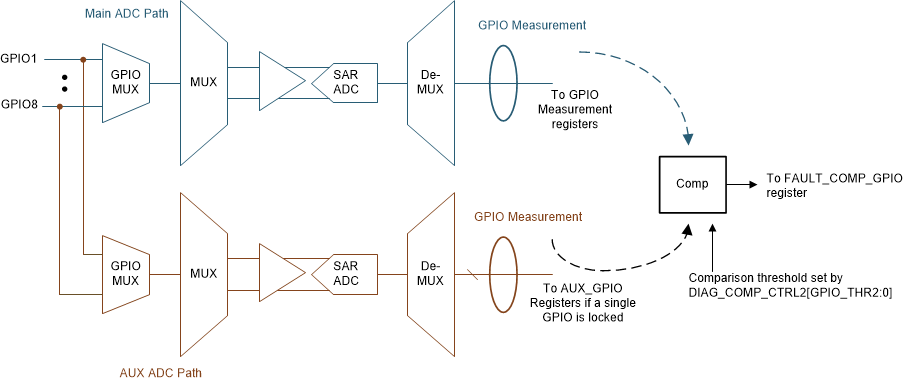ZHCSTD3B June 2022 – October 2023 BQ756506-Q1
PRODUCTION DATA
- 1
- 1 特性
- 2 应用
- 3 说明
- 4 Revision History
- 5 说明(续)
- 6 Pin Configuration and Functions
- 7 Specifications
-
8 Detailed Description
- 8.1 Overview
- 8.2 Functional Block Diagram
- 8.3
Feature Description
- 8.3.1 Power Supplies
- 8.3.2 Measurement System
- 8.3.3 Cell Balancing
- 8.3.4 Integrated Hardware Protectors
- 8.3.5 GPIO Configuration
- 8.3.6
Communication, OTP, Diagnostic Control
- 8.3.6.1 Communication
- 8.3.6.2 Fault Handling
- 8.3.6.3 Nonvolatile Memory
- 8.3.6.4 Diagnostic Control/Status
- 8.4 Device Functional Modes
- 8.5
Register Maps
- 8.5.1 OTP Shadow Register Summary
- 8.5.2 Read/Write Register Summary
- 8.5.3 Read-Only Register Summary
- 8.5.4
Register Field Descriptions
- 8.5.4.1 Device Addressing Setup
- 8.5.4.2 Device ID and Scratch Pad
- 8.5.4.3 General Configuration and Control
- 8.5.4.4 Operation Status
- 8.5.4.5 ADC Configuration and Control
- 8.5.4.6
ADC Measurement Results
- 8.5.4.6.1 VCELL6_HI/LO
- 8.5.4.6.2 VCELL5_HI/LO
- 8.5.4.6.3 VCELL4_HI/LO
- 8.5.4.6.4 VCELL3_HI/LO
- 8.5.4.6.5 VCELL2_HI/LO
- 8.5.4.6.6 VCELL1_HI/LO
- 8.5.4.6.7 MAIN_CURRENT_HI/LO
- 8.5.4.6.8 CURRENT_HI/MID/LO
- 8.5.4.6.9 TSREF_HI/LO
- 8.5.4.6.10 GPIO1_HI/LO
- 8.5.4.6.11 GPIO2_HI/LO
- 8.5.4.6.12 GPIO3_HI/LO
- 8.5.4.6.13 GPIO4_HI/LO
- 8.5.4.6.14 GPIO5_HI/LO
- 8.5.4.6.15 GPIO6_HI/LO
- 8.5.4.6.16 GPIO7_HI/LO
- 8.5.4.6.17 GPIO8_HI/LO
- 8.5.4.6.18 DIETEMP1_HI/LO
- 8.5.4.6.19 DIETEMP2_HI/LO
- 8.5.4.6.20 AUX_CELL_HI/LO
- 8.5.4.6.21 AUX_GPIO_HI/LO
- 8.5.4.6.22 AUX_BAT_HI/LO
- 8.5.4.6.23 AUX_REFL_HI/LO
- 8.5.4.6.24 AUX_VBG2_HI/LO
- 8.5.4.6.25 AUX_AVAO_REF_HI/LO
- 8.5.4.6.26 AUX_AVDD_REF_HI/LO
- 8.5.4.6.27 AUX_OV_DAC_HI/LO
- 8.5.4.6.28 AUX_UV_DAC_HI/LO
- 8.5.4.6.29 AUX_OT_OTCB_DAC_HI/LO
- 8.5.4.6.30 AUX_UT_DAC_HI/LO
- 8.5.4.6.31 AUX_VCBDONE_DAC_HI/LO
- 8.5.4.6.32 AUX_VCM_HI/LO
- 8.5.4.6.33 REFOVDAC_HI/LO
- 8.5.4.6.34 DIAG_MAIN_HI/LO
- 8.5.4.6.35 DIAG_AUX_HI/LO
- 8.5.4.7 Balancing Configuration, Control and Status
- 8.5.4.8 Protector Configuration and Control
- 8.5.4.9 GPIO Configuration
- 8.5.4.10 SPI Controller
- 8.5.4.11 Diagnostic Control
- 8.5.4.12 Fault Configuration and Reset
- 8.5.4.13
Fault Status
- 8.5.4.13.1 FAULT_SUMMARY
- 8.5.4.13.2 FAULT_COMM1
- 8.5.4.13.3 FAULT_OTP
- 8.5.4.13.4 FAULT_SYS
- 8.5.4.13.5 FAULT_PROT1
- 8.5.4.13.6 FAULT_PROT2
- 8.5.4.13.7 FAULT_OV2
- 8.5.4.13.8 FAULT_UV2
- 8.5.4.13.9 FAULT_OT
- 8.5.4.13.10 FAULT_UT
- 8.5.4.13.11 FAULT_COMP_GPIO
- 8.5.4.13.12 FAULT_COMP_VCCB2
- 8.5.4.13.13 FAULT_COMP_VCOW2
- 8.5.4.13.14 FAULT_COMP_CBOW2
- 8.5.4.13.15 FAULT_COMP_CBFET2
- 8.5.4.13.16 FAULT_COMP_MISC
- 8.5.4.13.17 FAULT_PWR1
- 8.5.4.13.18 FAULT_PWR2
- 8.5.4.13.19 FAULT_PWR3
- 8.5.4.14 Debug Control and Status
- 8.5.4.15
OTP Programming Control and Status
- 8.5.4.15.1 OTP_PROG_UNLOCK1A through OTP_PROG_UNLOCK1D
- 8.5.4.15.2 OTP_PROG_UNLOCK2A through OTP_PROG_UNLOCK2D
- 8.5.4.15.3 OTP_PROG_CTRL
- 8.5.4.15.4 OTP_ECC_TEST
- 8.5.4.15.5 OTP_ECC_DATAIN1 through OTP_ECC_DATAIN9
- 8.5.4.15.6 OTP_ECC_DATAOUT1 through OTP_ECC_DATAOUT9
- 8.5.4.15.7 OTP_PROG_STAT
- 8.5.4.15.8 OTP_CUST1_STAT
- 8.5.4.15.9 OTP_CUST2_STAT
- 9 Application and Implementation
- 10Power Supply Recommendations
- 11Layout
- 12Device and Documentation Support
- 13Mechanical, Packaging, and Orderable Information
8.3.6.4.6.2 Temperature Measurement Check
Similar to the cell voltage measurement check, the device checks the thermistor temperature measurement by comparing the Main ADC measurement to the AUX ADC measurement. To read the compared value measured by Main ADC and AUX ADC, MCU has lock on a single channel using [AUX_GPIO_SEL] setting and the start this diagnostic check. In this configuration, the compared values from Main ADC and AUX ADC are reported to DIAG_MAIN_HI/LO registers and DIAG_AUX_HI/LO registers respectively.
 Figure 8-33 Thermistor Temperature (GPIO) Measurement Diagnostic
Figure 8-33 Thermistor Temperature (GPIO) Measurement DiagnosticBefore starting the temperature measurement comparison, host ensures:
- Main ADC must be enabled and is in continuous mode.
- The desired GPIO channels to be tested are configured in the ADC_CTRL3[AUX_GPIO_SEL3:0] setting and AUX ADC is enabled and in continuous mode.
- Select the comparison threshold through DIAG_COMP_CTRL2[GPIO_THR2:0] setting.
To start the temperature measurement comparison:
- Set DIAG_COMP_CTRL3[COMP_ADC_SEL2:0] = GPIO measurement check (that is, 0b101) and set [COMP_ADC_GO] = 1.
- For each channel enabled by [AUX_GPIO_SEL4:0], the device will compare abs[(GPIO from Main – GPIO from AUX)] < [GPIO_THR2:0].
- Wait for the comparison to be accomplished which can take up to 64 ADC round robin times.
- The GPIO measurement comparison is completed when ADC_STAT2[DRDY_GPIO] = 1.
Host checks the FAULT_COMP_GPIO register for the comparison result.
ADC comparison abort conditions:
The device will not start the temperature measurement comparison under the invalid conditions listed below. When the comparison is aborted, the FAULT_COMP_MISC[COMP_ADC_ABORT] = 1, [DRDY_GPIO] = 1, and FAULT_COMP_GPIO = 0xFF. If [AUX_GPIO_SEL3:0] is set to locked at a single channel, the AUX_GPIO_HI/LO registers will be reset to default value 0x8000 if the comparison run is aborted.
Invalid conditions or settings which will prevent the start of the temperature measurement comparison:
- Invalid [AUX_GPIO_SEL] setting which the selected GPIO isn’t configured for ADC measurement. The AUX_GPIO_HI/LO registers are kept in default value. This also applies to the case if [AUX_GPIO_SEL] is selected for all GPIOs but none of the GPIOs are configured for ADC measurement.
- Main or AUX ADCs are off or not set in continuous mode.